Sachin Pratap |
Jharkhand, a state rich in mineral reserves and with a booming industrial sector, is at crossroads. While it plays a crucial role in India’s energy security, its current dependence on fossil fuels poses a challenge for a sustainable future. However, amidst these concerns lies immense potential – the potential of renewable energy across the state.


In the current situation for Jharkhand, coal dominates with over 93.7%, represented by a large black wedge in the Pie chart above. The contribution of hydroelectric power is at 4% and finally, solar power’s current share is just over 2.3%. We can see the installed capacity of solar power growth from 2016 it was about 16.19 MW and as of now it is 105.84 MW in the year 2023. The situation clearly indicates the need for a significant shift towards renewable sources of energy.
Jharkhand boasts an average solar radiation of 4.5 to 5.5 kWh/m², with over 300 clear sunny days annually. The MNRE has estimated the solar potential to be 18.18 GW across the state, which is the highest among its neighboring states, blessed with abundant sunshine the potential for solar could be a lot more. Along with the potential for significant hydroelectric generation and bioenergy, Jharkhand has the opportunity to transition away from fossil fuels and embrace a cleaner, greener future.
Jharkhand’s Solar Policy 2022 sets forth an ambitious vision for the future, aiming to achieve 4000 MW of solar capacity by 2027. This bold target, as outlined, necessitates a concerted efforts across various sectors and stakeholders. Data-driven insights will play a crucial role in shaping energy planning and facilitating a sustainable transition in the state. Realizing Jharkhand’s renewable energy potential requires informed decision-making, this is where dashboards come into play. Dashboards aggregates various data on technologies like solar power, hydro power, and bio-power utilization. This data is then transformed into easy-to-understand visuals using visualization tools. dashboards offer a multitude of benefits that are instrumental in guiding policy decisions, fostering innovation, and driving the transition towards sustainable energy systems.
Link for the dashboard: https://renewable-energy-installations-jharkhand.streamlit.app/
The Jharkhand Renewable Energy Dashboard offers a snapshot of renewable energy progress across the state’s districts. It highlights key data on various technologies like Solar Pumps, Rooftop Solar, Hydro, and Bio Power capacities. This includes details on installation counts and capacities for each technology in different districts. This dashboard has multiple pages for different ownership parties like state owned, private owned and public sector owned.
This dashboard has been developed through open source technologies and we collected data from Jharkhand Renewable Energy development agency (JREDA), and verified from different government officials.


Snapshots of the dashboard on Renewable Energy of Jharkhand
This dashboard has various information of solar rooftop installation locations in various government buildings such as District Courts, Police stations, Hospitals, Educational institutions and other offices like forest offices and district collectorate buildings, and the installations of streetlights in different districts of Jharkhand. By providing this information in one accessible platform, the dashboard supports informed decision-making and strategic planning for renewable energy initiatives in Jharkhand.
By leveraging data analytics, policymakers can identify optimal locations for utility-scale solar power plants, ensuring efficient resource utilization and maximum output. Similarly, collaboration between government agencies, private sector players, and communities is essential for the successful implementation of distributed solar power systems on rooftops and smaller scales, as well as off-grid solar solutions in remote areas.
Conclusion
This collaborative approach fosters knowledge sharing, technology transfer, and innovative solutions tailored to local needs. By harnessing the power of data and collaboration, Jharkhand can realize its ambitious solar targets, paving the way for a cleaner, more sustainable energy
future for generations to come.

